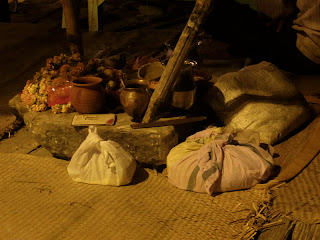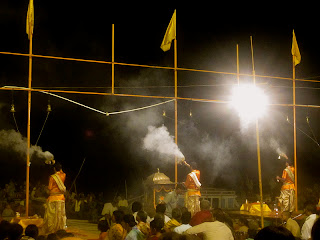It’s Time to go. On the way out of the hotel to meet Hapiz for my final trip into town, one of my sandals broke and I had to go back to my room to put on my shoes again. I have only worn closed shoes twice since here in India as well as on the set for the film. It is Time.
The concept of Liminality was coined by Arnold von Gennep in his 1909 book, “Rights of Passage.”
For Gennep, the liminal space was the most essential part of a passage from one stage to another. The initiate had to literally both physically and spiritually be removed from the normal status of life and thrown into an other “world,” in which he or she would endure a rite of passage, being made into a new person, and then re-integrated into society. The re-integration is crucial, for otherwise, an initiate can remain stuck in a terminal space of liminality, in perpetual limbo. Paralyzed from action.
Yesterday marked the nominal count of 7 billion people as the “official” census of the world’s population.
One in six of those people live in India. That is not a difficult concept for me to grasp having been here now for ten weeks. There are a lot of people.
India herself is in a liminal stage. The country is squarely between the First World of undeveloped and the Third World of “developed.” Like everything else in India, it takes the Second World to the extreme. There are many internal debates raging here. Is India the mythical, spiritual land of superstition and magic of ancient tribal religions, or is the next stop on the IT Superhighway? The answer is “Mu.” Neither and both at the same time.
Mu is a Japanese term for “no, but not no.” A negation and a negation of that negation at the same time, an infinite loop of negation, rendering the question null and void. India is a land that just took on F-1 with a new multi-million dollar race circuit while half the population is below the world poverty line. India is the land of Temples gopalums and Supercomputer towers. It is Bollywood millionaires and the slumdogs of Mumbai. Perhaps you saw that just this past week, a real “slumdog” won India’s millionaire show, a coincidence that is so common in India that they can no longer be called coincidences.
In the universities, protests are springing up all over India with manifestations against and for dress codes, keeping castes separate or breaking them down, racial profiling against non-vegetarians and Hindus, language divisions and barriers. In one major university in Delhi, book banning of “blasphemous” books has begun, sparking outrage and support at the same time.
In Forester’s “A Passage to India,” he divides the books into sections showing the intricate fabric of India’s major religions: Muslim, Hindu, Buddhist, and Jain, and their even further convolution with Christianity and Western beliefs and customs. India is all of this and much, much more.
It has the largest Identity Crisis of any country I have ever seen, and yet, simultaneously, I have never been in a country that was so certain of who it is. India knows that it is India. Make no mistake about that.
India is hyper-progressive, ultra-conservative, eternally stuck in the past, but with greater visions for the future than the rest of the world. It is the most complex and challenging place I can imagine being in.
It has challenged me. It has humbled me beyond measure and words. It has stripped me down of prejudices and preconceptions that serve no purpose.
Because of the sheer numbers of people, I have heard many times that India does not place a value on human life. I disagree. Nowhere else have I been that every single action revolves around “Being Human,” as the t-shirts say.
I am not so naïve as to think that every person is walking around chanting Sanskrit, contemplating the cycle of life, just as not all Europeans are sitting in cafes, drinking strong coffee and discussing politics and philosophy, nor do all Americans have picnics celebrating freedom, eating hotdogs and grilling hamburgers. And yet, they are. Like or not stereotypes exist for a reason, and each of these stereoptypes do exist and they are part of those countries. And, each one is part of me. I feel a kindred spirit to each one of these elements and they are what make me me.
Hapiz, my faithful Muslim Tuk-Tuk driver and guide says often, almost mantra-like, “Varanasi has three parts: one part Hindu, one part Muslim, one part Buddhist.” And, like the trimurti of Shiva that is one of many faces of India, each face has an infinite manifestations of avatars reflected in each one of us.
Like Indra’s Net, each of our lives are individual gems, infinitely reflecting all lives in our own. It is was connects us, even if we are so very distant, estranged, or in conflict.
This trip to India came at a crucial juncture in my life, a threshold to a new one, leaving behind and old one. India taught me not just how to be a human, but more importantly, like the third metamorphosis of Nietzsche’s Zarathustra, it taught me to view the world with the wonder of a child again, to be a child again.
Having just been to the so-called Monkey Temple (due to a plethora of monkeys in it), my last stop in Varanasi, and consequently India, I sat watching people from all walks of life file in and out of the temple, ringing the bell after the darshana, wafting the incense in their faces, listening to the chants in the background. Men, women, and children from all socio-economic levels filing past, one after another.
I could have stayed for a lifetime, but, I can’t. I am not from here. I am not Hindu and I am not Indian, and never can be in this lifetime. India was indeed a passage for me, a liminal Space and Time in which I learned again what is most important to me. I have been “alone” for 10 weeks, but never have I felt more full.
And, so, I left.





















































